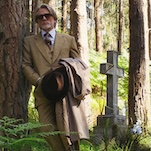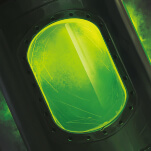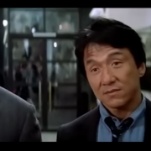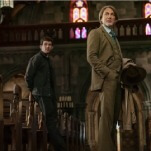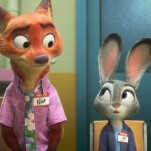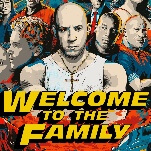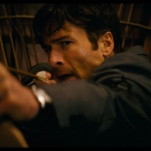Children dressed up in Halloween costumes are adorable. When Ellliott’s mom sees her three kids—one of whom is actually E.T. in disguise—in their get-ups, she lets out a delighted shriek and is subsequently unable to form coherent words for about half a minute, which is a pretty typical parental response. In order to find trick-or-treaters scary or threatening, you’d need to be either unfamiliar with Halloween as a concept, on powerful hallucinogens, or watching a horror movie. Or, in a pinch, you could just inhabit a mental state that combines the feeling of intense unfamiliarity (“jamais vu,” the lesser-known opposite of déjà vu) with the experience of having a bad trip while watching a horror marathon. For a person on the brink of complete mental and emotional collapse, Halloween becomes a living nightmare, and little kids in scary costumes might as well actually be the terrifying creatures they represent.
The superior, aggressively abstract first half of We Need To Talk About Kevin, Lynne Ramsay’s adaptation of Lionel Shriver’s novel, finds Eva Khatchadourian (Tilda Swinton) teetering on that edge. All we can gather, early on, is that her son, Kevin, has committed some horrible act, resulting in present-tense scenes of a broken woman whose husband and children, seen in flashbacks, are clearly no longer around. Additionally, Eva appears to be the town pariah, encountering violent hostility from people on the street and repeatedly finding her property vandalized. The movie gets shaky when it finally makes the source of this penance concrete (which is to say, when Kevin himself comes into focus), but Ramsay’s initial, fragmented portrait of isolation, guilt, and dissociation packs a mighty wallop. The most arresting sequence finds Eva driving home, alone with her tortured thoughts, when the world outside her car suddenly goes haywire.
Ramsay cannily puts us in Eva’s headspace by providing no previous indication whatsoever of the date, so that the appearance of strange figures through her window is as alarming to us as it is to her. Not until two kids—one in a store-bought skeleton costume, the other holding a standard-issue pumpkin candy-holder—cross in front of her car, fully illuminated by its headlights, does it become clear that she’s merely driving past a bunch of trick-or-treaters. While we can instantly relax, however, Eva cannot. Her expression remains fearful, and Ramsay reinforces her sense of dislocation by having subsequent kids loom blurrily into her (and our) field of vision, making booga-booga gestures and noises. In an ordinary context, this would be playful; from Eva’s point of view, it’s just another assault, only weirder. She’s not in a position to distinguish between being a specific target of hatred and a random target of spookiness.
The spooky quality is magnified by Ramsay’s counterintuitive choice of music for the sequence. If I had been asked, prior to seeing this movie, to rank the 17,973 songs in my iTunes library in descending order of their ability to suggest Halloween, Buddy Holly’s “Everyday” would likely have placed around 17,850. (It does beat The Flaming Lips’ “Christmas At The Zoo.”) To some extent, its lyrics reflect the film’s narrative, which is ultimately revealed to be about a mother who was inexplicably repelled by her child—lines like “do you ever long for true love from me?” subtly underline Eva’s feelings of guilt. But “Everyday” isn’t a mournful song. It’s bright and happy, and its use of the celesta (cousin to the glockenspiel) gives it an unmistakably innocent quality. In short, it’s the perfect evocation of what’s underneath all the masks and makeup, serving as a reminder both of what Eva can’t see and of the carefree childhood Kevin never had. The disjunction between sound and image works beautifully, mostly because all it takes is a slight mental readjustment—which Eva can’t make—to perceive that there isn’t actually any disjunction at all.
Ultimately, the question We Need To Talk About Kevin asks, and that Eva constantly asks herself, is this: Was she repulsed by Kevin because she sensed that he was evil, or was he horrifically warped because of her failure to love him? What’s fascinating about the Halloween sequence is that, on its surface, it seems to reinforce the more comforting of the two possibilities. Children are monsters, it declares, with no other purpose in life but to demand things from adults; the cheerful melody of “Everyday” (which kicks in at the tail end of the previous scene, before a single kid appears) is a lie. At the same time, though, one could easily interpret it the opposite way: that the apparent monstrousness is merely a disguise, something no sensible adult and loving parent would ever take seriously or allow to influence their feelings. Either way, Halloween can be an uncomfortable holiday for someone who’s recently experienced real horror (of the sort Kevin perpetrated—though, again, at this point in the film, its nature remains vague). Cute affectations of horror inevitably come across as mockery, however unintentional.
Upon arriving home, Eva quickly pours herself a glass of red wine (red being the movie’s dominant color, to an almost insane degree), then finds her house besieged by the trick-or-treaters, for whom she has no candy—or anything else, for that matter. Too frightened to greet them empty-handed, she douses the light and sinks to the floor, whereupon Ramsay rhymes the kids’ insistent pounding at the door and windows with a flashback to the very young Kevin throwing his food at the refrigerator. And it’s here, as the film cuts back and forth between past and present, that we see which of the two scenarios Eva favors. For there’s a third instant represented as well, in which Eva speaks to Kevin (and almost directly to the camera, thereby allying us with him rather than her) in an exaggerated baby-talk voice. This, too, is a flashback to Kevin’s infancy, but it’s separate from the food-throwing incident, clearly taking place in his bedroom rather than the kitchen. And it finds Eva saying the most horrible thing a mother could tell her child—in essence, that she wishes he had never been born. (The way Swinton gradually switches to a normal voice at the end, using the word “France” as if it were a hatchet, is typical of the film’s blackly comic approach to Eva’s efforts at motherhood.) When Eva’s husband (John C. Reilly), overhears her, he reacts not with alarm, but merely with resigned disgust, indicating how commonplace such verbal abuse was in their house… or maybe that’s just how Eva remembers it. Her mindset is clear. She’s the real monster.


